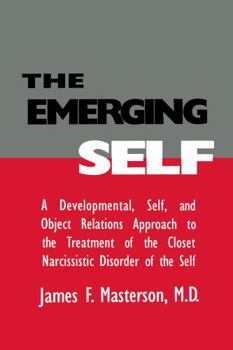The Emerging Self: A Developmental, .Self, And Object Relatio: A Developmental Self & Object Relations Approach To The Treatment Of The C
Select Format
Select Condition 
Book Overview
At last, this much?awaited volume sheds substantial light on one of the most difficult disorders to diagnose and treat: the closet narcissistic disorders of the self. The third of a series on the disorders of the self, and the first written by Dr. Masterson since 1985, the book fills a crucial niche in his work and in the field of personality disorders. It describes not only the psychopathology and treatment of this disorder but, more importantly, demonstrates the key dynamic of the disorders of the self triad: self activation leads to anxiety and depression, which leads to defense. This is the central dynamic of all the disorders of the self, and its particular manifestations in the closet narcissistic personality disorder are described along with the therapeutic techniques required to identify and manage it. The volume succeeds in clarifying a great deal of the clinical confusion surrounding the disorder, and addresses such questions as: What does the clinical picture look like? What is the reason for the diagnostic confusion? How does one resolve it? What other disorders does this disorder mimic? How do you differentiate it from the borderline and/or schizoid disorders of the self? What are some possible etiologic factors? What precipitates a clinical syndrome? What is the intrapsychic structure of this disorder, and how does it compare with other disorders? What is the central psychodynamic? What is a mirroring interpretation of narcissistic vulnerability, and why is it the intervention of choice? What is projective identification, and why is it so important to countertransference reactions to these patients? The Emerging Self offers a clear, down to earth, hands?on presentation of interest to all therapists students, teachers, and practitioners. It will enable the therapist to identify what emotional issues are on center stage, understand how to deal with it, and also how to evaluate the results of his or her efforts. Beyond that, it will illustrate the variations in countertransference that occur as a result of projective identification. Above all, the volume will take its substantial place alongside Psychotherapy of the Borderline Adult and The Real Self as one of the three pillars of Dr. Masterson's whole theoretical approach.
Format:Paperback
Language:English
ISBN:1138005002
ISBN13:9781138005006
Release Date:February 2015
Publisher:Routledge
Length:340 Pages
Weight:0.97 lbs.
Dimensions:0.8" x 5.9" x 8.9"
Customer Reviews
2 ratings
What am I doing here? !
Published by Thriftbooks.com User , 16 years ago
I'm not surprised that it's Sam who is the only other reviewer (so far?). As a former computer programmer, I love the flowcharts explaining who's on first, what's on etc., of each of the main brain patterns. The first 3-4 chapters and the last few give detailed explanations of what we're doing in therapy and how, slicing it thinner than Emeril. The taped supervisory sessions could make you puke, if, like me, you're a patient who's been struggling with her therapists' countertransference for far too long. Need to be fluent in self-object jargon (which, after a year of self-study, I am). Also, unclear to me, on first reading of patient sessions, tone or intent of JM's comments (not 'interpretations'), but that's likely(!) my defense...
Outing the Narcissist
Published by Thriftbooks.com User , 23 years ago
Masterson is one of the few theoreticians [come] practitioners to offer a coherent and self-sufficient theory of personality disorders, including the narcissistic one. This book encourages diagnosticians to diagnose pathological narcissism, even when the presenting signs are misleading. Masterson believes in the unacanny ability of pernicious narcissism to disguise itself and manifest in numerous, uncharted, ways. His is a road map backed by impressive amounts of research and practice. The only drawback is that it presents only the views of the psychodynamic [come]object relations school of psychology and largely ignores advances in other fields. Sam Vaknin, author of "Malignant Self Love - Narcissism Revisited".






